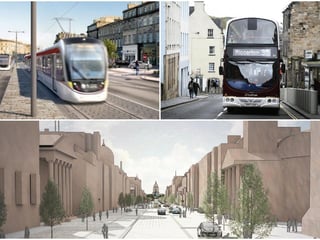Why cars cannot continue to rule the road in Edinburgh – Angus Robertson


Scotland’s capital city is set for a transport revolution. Over the next ten years exponentially more people in Edinburgh will use public transport, cycle and walk.
Edinburgh City Council is to consider a radical and exciting City Mobility Plan on Thursday which will then go out to public consultation. Members of the public and stakeholders will have eight weeks to take part in the consultation during February and March if the plan gets the go-ahead. All of this is essential if we want Edinburgh to become a net carbon zero city by 2030.
Advertisement
Hide AdAdvertisement
Hide AdAt present, transportation is the biggest single contributor to carbon dioxide levels, with just over one-third of CO2 emissions coming from road transport alone. This is not sustainable. It is also not disputed what the main cause of the pollution is: the car and the inefficient way we use them.
Cars can only deliver between 800 and 1100 people an hour along a four metre-wide road, while buses manage between 8000 to 12,000, while walking and cycling amounts to between 5000 and 10,000. Cars take up five to ten times as much road space.
Ecologically responsible
In Edinburgh, 45 per cent of the workforce commutes to work by car, while 65 per cent of all journeys in total are made by car or van, while 66 per cent of journeys are single occupancy. This is also not sustainable. Other European cities have shown that another future is possible. It is hugely encouraging that Edinburgh has the ambition to be a leader in the change from the unsustainable and environmentally damaging, to being sustainable and ecologically responsible. It also means a huge boost in quality of life for people living in Edinburgh.
Already, there are some encouraging signs with the Capital having the highest bus use in Scotland, with 30 per cent of adults travelling by bus every day. If the new City Mobility Plan comes about, we can look forward to an extension of the tram line to Newhaven and a review of bus routes by 2022.
Lower pollution
Advertisement
Hide AdAdvertisement
Hide AdWithin five years the target is to have a comprehensive mass rapid transit plan, development of park and ride and logistics hubs, and improved bus and tram systems. In ten years, the hope is to see the current tram line extended to Newbridge, while a new line will connect the Waterfront in the north to the Royal Infirmary and beyond to the south. All of this comes as part of a comprehensive joined-up plan which includes a city centre low emission zone, better walking and cycling networks, enhanced pedestrianisation and lower pollution.
Congratulations to the SNP-Labour Edinburgh City Council administration for having the vision to make the bold and necessary proposals. Our civic leaders, Adam McVey and Cammy Day, and their councillor colleagues, should be encouraged for their ambition to make Edinburgh a greener and better connected city, with a high quality of life.
No doubt there will be bumps on the road, delays to certain plans, inconvenience because of building work, budgetary pressures and plenty other challenges besides. All of that happens with changes to transportation systems. The status quo is not an option for Edinburgh. The City Mobility Plan has much to commend it. I’d recommend everyone takes a look at it and contributes to the consultation via www.edinburgh.gov.uk.
